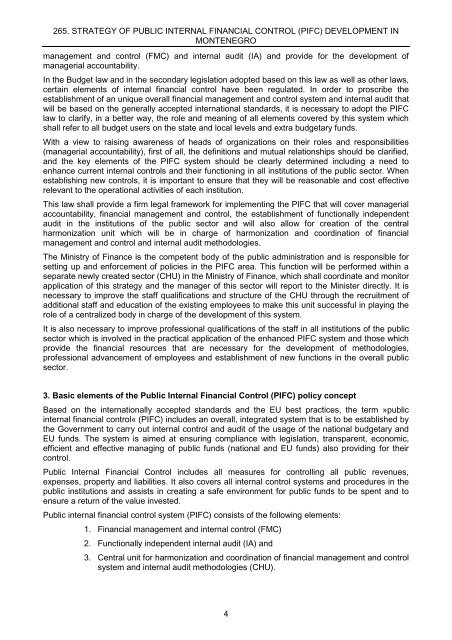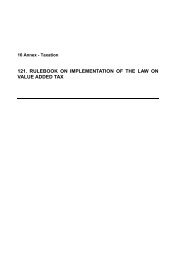265. strategy of public internal financial control (pifc) development in ...
265. strategy of public internal financial control (pifc) development in ...
265. strategy of public internal financial control (pifc) development in ...
You also want an ePaper? Increase the reach of your titles
YUMPU automatically turns print PDFs into web optimized ePapers that Google loves.
<strong>265.</strong> STRATEGY OF PUBLIC INTERNAL FINANCIAL CONTROL (PIFC) DEVELOPMENT INMONTENEGROmanagement and <strong>control</strong> (FMC) and <strong><strong>in</strong>ternal</strong> audit (IA) and provide for the <strong>development</strong> <strong>of</strong>managerial accountability.In the Budget law and <strong>in</strong> the secondary legislation adopted based on this law as well as other laws,certa<strong>in</strong> elements <strong>of</strong> <strong><strong>in</strong>ternal</strong> <strong>f<strong>in</strong>ancial</strong> <strong>control</strong> have been regulated. In order to proscribe theestablishment <strong>of</strong> an unique overall <strong>f<strong>in</strong>ancial</strong> management and <strong>control</strong> system and <strong><strong>in</strong>ternal</strong> audit thatwill be based on the generally accepted <strong>in</strong>ternational standards, it is necessary to adopt the PIFClaw to clarify, <strong>in</strong> a better way, the role and mean<strong>in</strong>g <strong>of</strong> all elements covered by this system whichshall refer to all budget users on the state and local levels and extra budgetary funds.With a view to rais<strong>in</strong>g awareness <strong>of</strong> heads <strong>of</strong> organizations on their roles and responsibilities(managerial accountability), first <strong>of</strong> all, the def<strong>in</strong>itions and mutual relationships should be clarified,and the key elements <strong>of</strong> the PIFC system should be clearly determ<strong>in</strong>ed <strong>in</strong>clud<strong>in</strong>g a need toenhance current <strong><strong>in</strong>ternal</strong> <strong>control</strong>s and their function<strong>in</strong>g <strong>in</strong> all <strong>in</strong>stitutions <strong>of</strong> the <strong>public</strong> sector. Whenestablish<strong>in</strong>g new <strong>control</strong>s, it is important to ensure that they will be reasonable and cost effectiverelevant to the operational activities <strong>of</strong> each <strong>in</strong>stitution.This law shall provide a firm legal framework for implement<strong>in</strong>g the PIFC that will cover managerialaccountability, <strong>f<strong>in</strong>ancial</strong> management and <strong>control</strong>, the establishment <strong>of</strong> functionally <strong>in</strong>dependentaudit <strong>in</strong> the <strong>in</strong>stitutions <strong>of</strong> the <strong>public</strong> sector and will also allow for creation <strong>of</strong> the centralharmonization unit which will be <strong>in</strong> charge <strong>of</strong> harmonization and coord<strong>in</strong>ation <strong>of</strong> <strong>f<strong>in</strong>ancial</strong>management and <strong>control</strong> and <strong><strong>in</strong>ternal</strong> audit methodologies.The M<strong>in</strong>istry <strong>of</strong> F<strong>in</strong>ance is the competent body <strong>of</strong> the <strong>public</strong> adm<strong>in</strong>istration and is responsible forsett<strong>in</strong>g up and enforcement <strong>of</strong> policies <strong>in</strong> the PIFC area. This function will be performed with<strong>in</strong> aseparate newly created sector (CHU) <strong>in</strong> the M<strong>in</strong>istry <strong>of</strong> F<strong>in</strong>ance, which shall coord<strong>in</strong>ate and monitorapplication <strong>of</strong> this <strong>strategy</strong> and the manager <strong>of</strong> this sector will report to the M<strong>in</strong>ister directly. It isnecessary to improve the staff qualifications and structure <strong>of</strong> the CHU through the recruitment <strong>of</strong>additional staff and education <strong>of</strong> the exist<strong>in</strong>g employees to make this unit successful <strong>in</strong> play<strong>in</strong>g therole <strong>of</strong> a centralized body <strong>in</strong> charge <strong>of</strong> the <strong>development</strong> <strong>of</strong> this system.It is also necessary to improve pr<strong>of</strong>essional qualifications <strong>of</strong> the staff <strong>in</strong> all <strong>in</strong>stitutions <strong>of</strong> the <strong>public</strong>sector which is <strong>in</strong>volved <strong>in</strong> the practical application <strong>of</strong> the enhanced PIFC system and those whichprovide the <strong>f<strong>in</strong>ancial</strong> resources that are necessary for the <strong>development</strong> <strong>of</strong> methodologies,pr<strong>of</strong>essional advancement <strong>of</strong> employees and establishment <strong>of</strong> new functions <strong>in</strong> the overall <strong>public</strong>sector.3. Basic elements <strong>of</strong> the Public Internal F<strong>in</strong>ancial Control (PIFC) policy conceptBased on the <strong>in</strong>ternationally accepted standards and the EU best practices, the term »<strong>public</strong><strong><strong>in</strong>ternal</strong> <strong>f<strong>in</strong>ancial</strong> <strong>control</strong>« (PIFC) <strong>in</strong>cludes an overall, <strong>in</strong>tegrated system that is to be established bythe Government to carry out <strong><strong>in</strong>ternal</strong> <strong>control</strong> and audit <strong>of</strong> the usage <strong>of</strong> the national budgetary andEU funds. The system is aimed at ensur<strong>in</strong>g compliance with legislation, transparent, economic,efficient and effective manag<strong>in</strong>g <strong>of</strong> <strong>public</strong> funds (national and EU funds) also provid<strong>in</strong>g for their<strong>control</strong>.Public Internal F<strong>in</strong>ancial Control <strong>in</strong>cludes all measures for <strong>control</strong>l<strong>in</strong>g all <strong>public</strong> revenues,expenses, property and liabilities. It also covers all <strong><strong>in</strong>ternal</strong> <strong>control</strong> systems and procedures <strong>in</strong> the<strong>public</strong> <strong>in</strong>stitutions and assists <strong>in</strong> creat<strong>in</strong>g a safe environment for <strong>public</strong> funds to be spent and toensure a return <strong>of</strong> the value <strong>in</strong>vested.Public <strong><strong>in</strong>ternal</strong> <strong>f<strong>in</strong>ancial</strong> <strong>control</strong> system (PIFC) consists <strong>of</strong> the follow<strong>in</strong>g elements:1. F<strong>in</strong>ancial management and <strong><strong>in</strong>ternal</strong> <strong>control</strong> (FMC)2. Functionally <strong>in</strong>dependent <strong><strong>in</strong>ternal</strong> audit (IA) and3. Central unit for harmonization and coord<strong>in</strong>ation <strong>of</strong> <strong>f<strong>in</strong>ancial</strong> management and <strong>control</strong>system and <strong><strong>in</strong>ternal</strong> audit methodologies (CHU).4



